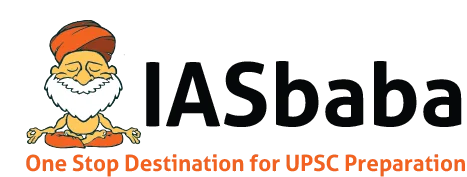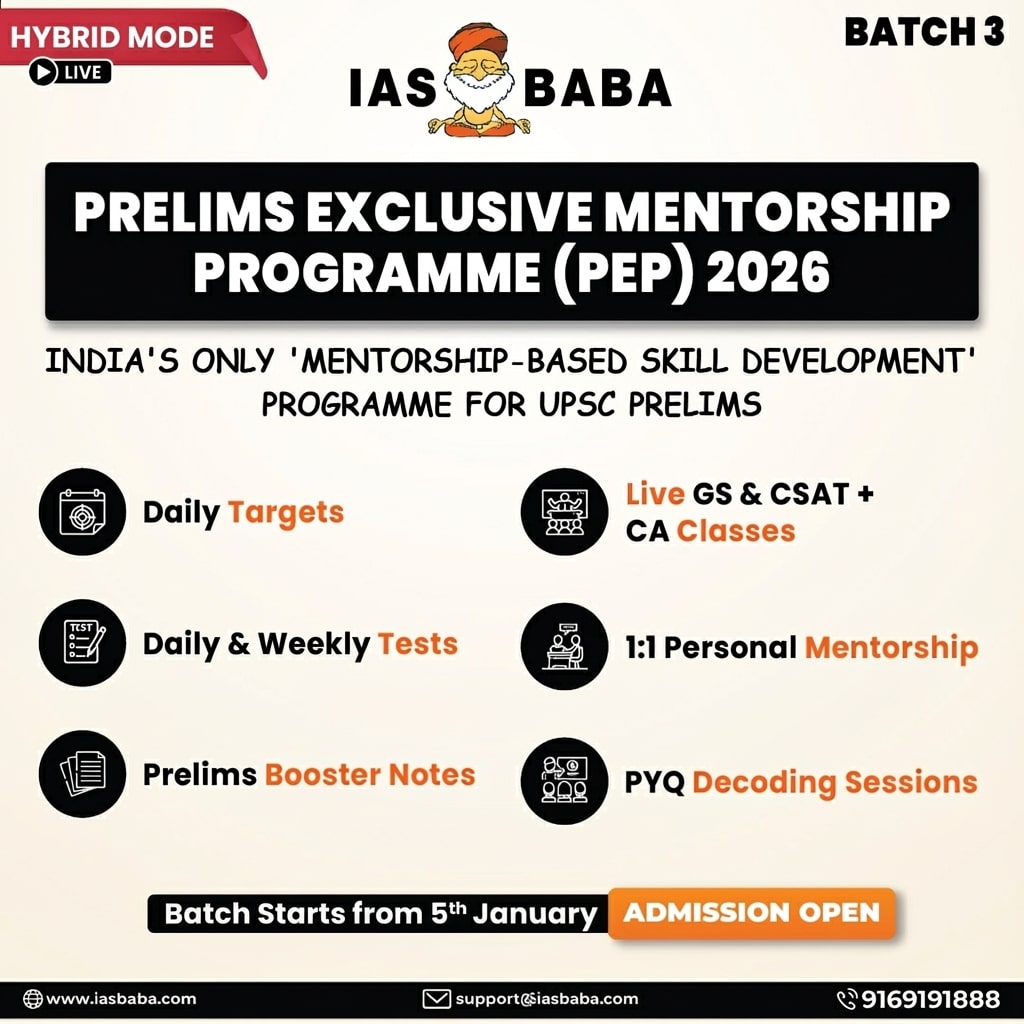IASbaba Daily Prelims Quiz
For Previous Daily Quiz (ARCHIVES) – CLICK HERE
The Current Affairs questions are based on sources like ‘The Hindu’, ‘Indian Express’ and ‘PIB’, which are very important sources for UPSC Prelims Exam. The questions are focused on both the concepts and facts. The topics covered here are generally different from what is being covered under ‘Daily Current Affairs/Daily News Analysis (DNA) and Daily Static Quiz’ to avoid duplication. The questions would be published from Monday to Saturday before 2 PM. One should not spend more than 10 minutes on this initiative.
Gear up and Make the Best Use of this initiative.
Do remember that, “the difference between Ordinary and EXTRA-Ordinary is PRACTICE!!”
Important Note:
- Don’t forget to post your marks in the comment section. Also, let us know if you enjoyed today’s test 🙂
- After completing the 5 questions, click on ‘View Questions’ to check your score, time taken, and solutions.
Test-summary
0 of 5 questions completed
Questions:
- 1
- 2
- 3
- 4
- 5
Information
To view Solutions, follow these instructions:
- Click on – ‘Start Test’ button
- Solve Questions
- Click on ‘Test Summary’ button
- Click on ‘Finish Test’ button
- Now click on ‘View Questions’ button – here you will see solutions and links.
You have already completed the test before. Hence you can not start it again.
Test is loading...
You must sign in or sign up to start the test.
You have to finish following test, to start this test:
Results
0 of 5 questions answered correctly
Your time:
Time has elapsed
You have scored 0 points out of 0 points, (0)
| Average score |
|
| Your score |
|
Categories
- Not categorized 0%
| Pos. | Name | Entered on | Points | Result |
|---|---|---|---|---|
| Table is loading | ||||
| No data available | ||||
- 1
- 2
- 3
- 4
- 5
- Answered
- Review
-
Question 1 of 5
1. Question
-
Consider the following statements:
-
Pre-emergent herbicides are primarily preventive in nature, while post-emergent herbicides act as curative agents targeting already germinated weeds.
-
Fungicides and herbicides are both used to control living organisms that directly compete with crops for sunlight and soil nutrients.
Which of the statements given above is/are correct?
Correct
-
Solution: (a)
Explanation:
- Statement 1 pre-emergent herbicides prevent weed seeds from germinating, while post-emergent herbicides target weeds after emergence. Hence the statement is Correct
Statement 2 Fungicides target fungal pathogens causing plant diseases, not organisms competing for sunlight or nutrients. Herbicides target weeds that compete for such resources. Hence the statement is Incorrect
Incorrect
-
Solution: (a)
Explanation:
- Statement 1 pre-emergent herbicides prevent weed seeds from germinating, while post-emergent herbicides target weeds after emergence. Hence the statement is Correct
Statement 2 Fungicides target fungal pathogens causing plant diseases, not organisms competing for sunlight or nutrients. Herbicides target weeds that compete for such resources. Hence the statement is Incorrect
-
-
Question 2 of 5
2. Question
-
Consider the following statements regarding Small Finance Banks (SFBs):
-
SFBs are not permitted to accept demand deposits from the public.
-
SFBs are required to lend at least 75% of their Adjusted Net Bank Credit to the priority sector.
-
At least 50% of SFBs’ loan portfolio must comprise loans and advances up to ₹25 lakh.
Which of the statements given above is/are correct?
Correct
-
Solution: (b)
Explanation:
- Statement 1: SFBs can accept demand deposits, including savings and current accounts. Hence the statement is Incorrect
- Statement 2: They must lend at least 75% of ANBC to the priority sector. Hence the statement is Correct
Statement 3: At least 50% of their loan portfolio should be loans up to ₹25 lakh to promote inclusion. Hence the statement is Correct
Incorrect
-
Solution: (b)
Explanation:
- Statement 1: SFBs can accept demand deposits, including savings and current accounts. Hence the statement is Incorrect
- Statement 2: They must lend at least 75% of ANBC to the priority sector. Hence the statement is Correct
Statement 3: At least 50% of their loan portfolio should be loans up to ₹25 lakh to promote inclusion. Hence the statement is Correct
-
-
Question 3 of 5
3. Question
-
Consider the following statements
Statement 1 (S1): The WTO’s principle of Most Favoured Nation (MFN) treatment ensures that any trade advantage granted by a member to one country must be extended to all WTO members.
Statement 2 (S2): This principle allows WTO members to offer preferential trade benefits exclusively to countries with which they have signed Free Trade Agreements (FTAs).
Which one of the following is correct?
Correct
-
Solution: (c)
Explanation:
- S1 – Correct: MFN is a core WTO principle promoting non-discrimination in trade by extending equal treatment to all members.
S2 – Incorrect: FTAs are an exception to the MFN rule, permitted under WTO’s Article XXIV, allowing members to give preferential treatment to FTA partners without extending it to all members.
Incorrect
-
Solution: (c)
Explanation:
- S1 – Correct: MFN is a core WTO principle promoting non-discrimination in trade by extending equal treatment to all members.
S2 – Incorrect: FTAs are an exception to the MFN rule, permitted under WTO’s Article XXIV, allowing members to give preferential treatment to FTA partners without extending it to all members.
-
-
Question 4 of 5
4. Question
-
Consider the following statements
-
Primary prophylaxis is aimed at preventing the occurrence of disease, while secondary prophylaxis focuses on preventing recurrence or progression of an existing condition.
-
In infectious diseases, chemoprophylaxis can be part of both primary and secondary prophylaxis strategies.
-
Herd immunity achieved through vaccination is an example of tertiary prophylaxis.
Which of the statements given above is/are correct?
Correct
-
Solution: (b)
Explanation:
- Statement 1: This is the fundamental distinction between primary and secondary prophylaxis. Hence the statement is Correct
- Statement 2: For example, antimalarial drugs before travel (primary) or long-term antibiotics post-rheumatic fever (secondary). Hence the statement is Correct
Statement 3: Herd immunity via vaccination is primary prophylaxis, not tertiary. Tertiary prophylaxis deals with reducing impact or complications of established disease. Hence the statement is Incorrect
Incorrect
-
Solution: (b)
Explanation:
- Statement 1: This is the fundamental distinction between primary and secondary prophylaxis. Hence the statement is Correct
- Statement 2: For example, antimalarial drugs before travel (primary) or long-term antibiotics post-rheumatic fever (secondary). Hence the statement is Correct
Statement 3: Herd immunity via vaccination is primary prophylaxis, not tertiary. Tertiary prophylaxis deals with reducing impact or complications of established disease. Hence the statement is Incorrect
-
-
Question 5 of 5
5. Question
-
The legacy of M. S. Swaminathan is often described as moving Indian agriculture from a stage of “ship-to-mouth” to “self-sufficiency.”
Which of the following best captures the conceptual significance of this transformation in the broader context of India’s developmental strategy?
Correct
-
Solution: (b)
Explanation:
- Option a: Import substitution was an element, but industrialization remained a parallel focus under India’s mixed economy approach. Hence the statement is incorrect
- Option b: Swaminathan’s Green Revolution strategy wasn’t merely about yields; it linked scientific innovation with rural livelihoods, food security, and reduction of dependence on food imports, thus blending productivity with socio-economic goals. Hence the statement is correct
- Option c: The Green Revolution complemented, not replaced, the industrial strategy. Hence the statement is incorrect
- Option d: India did not pursue complete autarky; it remained engaged in global markets, though food import dependency fell sharply. Hence the statement is incorrect
Incorrect
-
Solution: (b)
Explanation:
- Option a: Import substitution was an element, but industrialization remained a parallel focus under India’s mixed economy approach. Hence the statement is incorrect
- Option b: Swaminathan’s Green Revolution strategy wasn’t merely about yields; it linked scientific innovation with rural livelihoods, food security, and reduction of dependence on food imports, thus blending productivity with socio-economic goals. Hence the statement is correct
- Option c: The Green Revolution complemented, not replaced, the industrial strategy. Hence the statement is incorrect
- Option d: India did not pursue complete autarky; it remained engaged in global markets, though food import dependency fell sharply. Hence the statement is incorrect
-
- Current Affairs Quiz, IAS Daily Current Affairs Quiz, IAS UPSC Current Affairs Quiz, IAS UPSC Prelims Quiz, IASbaba's Current Affairs Prelims Quiz, IASbaba's Daily Quiz, IASbaba's UPSC Quiz, Prelims Current Affairs Quiz, UPSC Current Affairs Quiz, UPSC Current Affairs Quiz IASbaba, UPSC Daily Current Affair Quiz, UPSC IAS Daily Quiz














